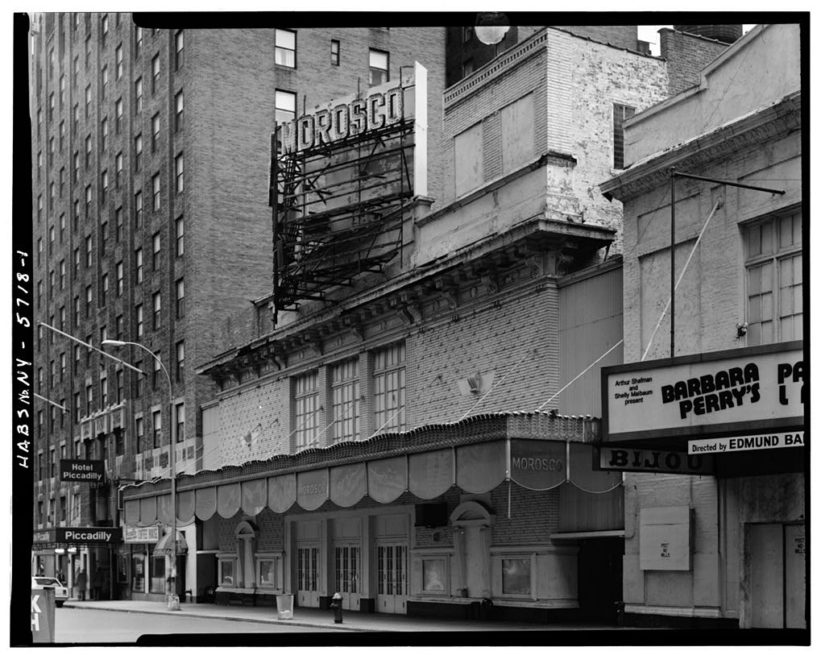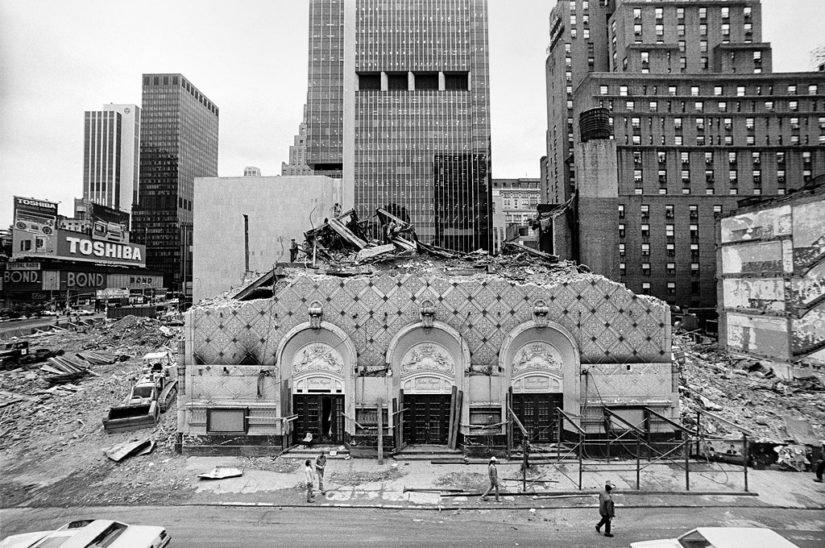
Helen Hayes & Morosco Theatres
These two theaters were demolished during the redevelopment of the Theater District, sparking a movement to preserve the cultural and architectural legacy of the area.
The Helen Hayes Theatre opened to much fanfare on April 27, 1911. Originally called the Folies Bergère, and modeled after the Parisian music hall of the same name, The New York Times stated that the venue “cannot be treated as an ordinary entertainment or an ordinary playhouse,” due to the theatre’s “combination of music and spectacle and food and drink.”1 The architectural firm Herts & Tallant adorned the façade with gold, turquoise, and ivory terra cotta, lending vibrant colors to the Moorish Revival structure.2 While providing food and entertainment was a unique concept, it did not prove to be a viable business model. To shore up the theater’s finances, owners Henry B. Harris and Jesse Lackey renamed the Folies Bergère the Fulton Theatre and focused entirely on entertainment. In 1955 the theatre changed names yet again, this time honoring the legendary Broadway actress Helen Hayes.
The Morosco Theatre was built in 1917 during one of Times Square’s most prosperous eras. In the early 20th century, Times Square was deemed the “most densely populated place in the world at night,” boasting over six million visitors a week.3 Herbert J. Krapp designed the Morosco for the Shubert brothers, two of Broadways most powerful magnates. With 905 seats, the Morosco was appreciated for its intimate scale and perfect acoustics, an ideal setting for any spoken word drama.4 Upon the theatre’s opening on February 5, 1917, The New York Times described the interior as “comfortable” with an “attractive color scheme of gray and purple greeted its first audience after they had passed through the lobby.”5
The Helen Hayes and Morosco Theatres, along with the Bijou, Astor, and Gaiety Theatres, were victims of the “Great Theatre Massacre of 1982” in which several historic theatres were demolished to make way for the 50-story Marriot Marquis Hotel. In 1978, prior to the demolition of the theatres, the sites were designated as eligible for the National Register of Historic Places.6
1973: Atlanta-based hotelier John C. Portman, Jr. announces plans for a sprawling modernist hotel complex directly in the heart of Times Square but support for the development lags as the economy falters
1978: Mayor Ed Koch’s administration lures Portman back to New York in an attempt to cleanse Times Square of its “decadent” reputation
December 26, 1978: The Helen Hayes & Morosco Theatres are deemed eligible for the National Register of Historic Places
March 22, 1982: Demolition commences on the Morosco and Helen Hayes Theatres
March 23, 1982: Actors such as Richard Gere, Tammy Grimes, Michael Moriaty and Treat Williams arrested for obstruction of demolition
March 27, 1982: Demolition of the Helen Hayes Theatre briefly halted to comply with a mandate to preserve objects of historic and architectural interest
June 9, 1982: Two thirds of front façade of the Helen Hayes Theatre collapses onto the street
August 7, 1985: Neil Simon, Virginia, and Ambassador Theatres designated as New York City landmarks
September 4, 1985: Marriott Marquis Hotel opens its doors
1987: By this year, 25 Broadway theatres had been designated New York City landmarks

In the second half of the 20th century, Times Square had fallen on hard times. While the Theater District was intact, the area was blighted by crime. In an attempt to revitalize the Theater District, Mayor Ed Koch’s administration turned towards development as a potential impetus for revitalization. Backed with funding from the New York State Urban Development Corporation, a state-owned entity, the Marriot Marquis Hotel was to be the catalyst for the renewal of Times Square. Standing in the way of this massive development were several theatres, including the Helen Hayes and Morosco.7
Although the preservation community had been successful in gaining landmark status for Radio City Musical Hall and the New Amsterdam Theatre, community organizers faced an obstacle when Portman’s plans were announced for the demolition of the Morosco and Helen Hayes theatres.8 Preservationists formed the group Save the Theaters Incorporated, which worked alongside the Actors’ Equity Association in order to preserve the theaters in the district. Publicity campaigns, started by Save the Theaters Incorporated, attracted support from a host of show business celebrities. However, due to the municipal government’s zealousness in pursuing the redevelopment of Times Square, the Landmarks Preservation Commission was pressured to vote against designating the theaters.9
Designed by developer and architect Robert C. Portman, Jr. the Marriot Marquis was described by architectural critic Paul Goldberger as “a small-town view of urban glamour more than any true vision of urban sophistication.”10 Many believed that this was another example of the supposed revival of New York City robbing the metropolis of its character.
Architect Lee Harris Pomeroy prepared an alternative design that retained Portman’s major amenities—an atrium, exhibition halls, restaurants, lobbies and retail shops—but by reorienting the hotel 180 degrees, allowing incorporation of the historic theaters in the new development. The proposal received enthusiastic, widespread support from Actor’s Equity, the Municipal Art Society of New York, the American Institute of Architects and the New York Landmarks Conservancy. Protests and a heated legal battle ensued.11
The demolition of the Helen Hayes and Morosco Theatres was briefly halted due to a temporary injunction filed by Judge Jacob D. Fuchsberg of the New York State Court of Appeals. However, the New York State Court of Appeals ruled unanimously to vacate the temporary injunction on March 17, 1982.12 While the Court of Appeals had approved the demolition of the two theatres, the final decision regarding their fate rested with the Supreme Court, which had ordered a stay on the lesser court’s ruling.
When protesters and activists were informed of the Supreme Court’s ruling allowing demolition to proceed on March 22, 1982, actor Christopher Reeve described the preservation effort as “a battle between artists and technology,” one that had to be fought to “insure that New York never becomes another Pittsburgh or Seattle or Houston.”13
While the New York City Landmarks Preservation Committee sanctioned the demolition of the Helen Hayes Theatre, the organization did add certain stipulations. A third of the theatre’s terra cotta façade was to be preserved along with certain design elements and memorabilia. Although portions façade was earmarked for preservation, on June 9, 1982, a substantial segment of the façade collapsed onto the street below. In response to this embarrassment, Portman Properties responded to The New York Times by stating, “the contractor took more of the front wall than anyone would like to see, but if we really analyze it, it’s not all that bad.”14 Sandy Lundwall of the Actors’ Equity Committee lambasted this statement as a violation of the developer’s agreement with the Landmarks Preservation Commission. Despite this collapse, some of the remains of the Helen Hayes Theatre were indeed distributed to museums, theatre groups, and prominent individuals in the theatre community.
Similar to the demolition of Pennsylvania Station, the rise of the Marriott Marquis Hotel led to a renewed push for the landmark designation of historic buildings in New York City and specifically the Theater District. Save the Theatres Inc. and the Actors’ Equity Foundation worked alongside such prominent New Yorkers as Joseph Papp, Woody Allen, Carole Burnett, Paul Newman, Joanne Woodward, and Alan Alda, as well as the National Endowment for the Arts and the National Trust for Historic Preservation to come up with recommendations to protect the unique character of the Theater District while encouraging appropriate real estate development.
On August 7, 1985, one month prior to the opening of the Marriott Marquis, the New York City Landmarks Preservation Commission gave landmark status to the Neil Simon, Virginia (both designed by the architect of the Morosco Theatre), and Ambassador Theatres.15 By 1987, 25 Broadway theaters had been designated as New York City landmarks; eventually 46 Broadway theaters would gain landmark status and zoning was crafted to include air rights transfers that would encourage mixed-use development in the area.
For a complete history of the rezoning of the Theater District, the fight to save the historic Helen Hayes and Morosco, and the subsequent designation of the remaining theaters, see chapters 15 and 16 of Roberta Brandes Gratz's The Living City: How America's Cities Are Being Revitalized by Thinking Small in a Big Way (Wiley, 1994).

- Oral History with Joseph Rosenberg
New York Preservation Archive Project
174 East 80th Street
New York, NY 10075
Tel: (212) 988-8379
Email: info@nypap.org - Roberta Brandes Gratz, "Save the Helen Hayes," New York Magazine, 19 November 1979.
- “FOLIES BERGERE FULL OF NOVELTIES; New “Parisian” Theatre Opens with Satirical Burlesque “Hell,” with Spectacular Marches,” 28 April 1911.
- “Helen Hayes Theater,” New York Architecture Images, accessed 14 July 2016.
- Robert A. M. Stern, Thomas Mellins & David Fishman, New York 1960: Architecture and Urbanism between the Second World War and the Bicentennial (New York: Monacelli Press, 1995), page 432.
- Gregory Gilmartin, Shaping the City: New York and the Municipal Art Society (New York: Clarkson Potter, 1995), page 447.
- “The Great Theatre Massacre of 1982: Five Broadway Stages Faced the Wrecking Ball for a Marriott,” Keith York City, accessed 28 July 2016.
- “Case 75: Natural Resources Defense Council v. City of New York,” accessed 14 July 2016.
- “The Great Theatre Massacre of 1982: Five Broadway Stages Faced the Wrecking Ball for a Marriott,” Keith York City, accessed 28 July 2016.
- Paul Goldberger, “Architecture View; Broadway Need Not Become a Doormat for Skyscapers,” The New York Times, 13 April 1986.
- Interview with Joseph Rosenberg, New York Preservation Archive Project, 17 October 2007.
- Paul Goldberger, “Marriott Marquis Hotel: An Edsel in Time Sq.?,” The New York Times, 31 August 1985.
- Proposal to Save Morosco and Helen Hayes Theaters, Lee Harris Pomeroy Architects, accessed 5 August 2016.
- John Kennedy, “N.Y. Court Removes Bar to Theater Demolition,” Washington Post, 17 March 1982.
- Frank J. Prial, “Court Stay Lifted And Demolition Begins at Two Broadway Theaters,” The New York Times, 23 March 1982.
- Carol Lawson, “Fallen Facade Revives Theater Razing Dispute,” 9 June 1982.
- Jeffrey Schmalz, “Landmarks Panel Listing Broadway Theaters,” 7 August 1985.




